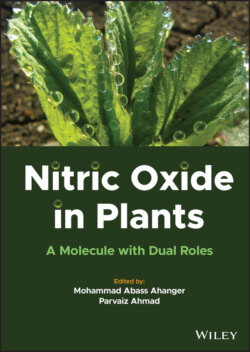Читать книгу Nitric Oxide in Plants - Группа авторов - Страница 10
1.1.2 NO Biosynthesis in Plants
ОглавлениеThe process of NO production has been explored in a variety of organisms, including microorganisms, alga, lichens, gymnosperms, and angiosperms (Rőszer et al. 2014). NO synthesis utilizes both accelerator and nonaccelerator mechanisms. Body parts, plastids, mitochondria, and peroxisomes are important sites for NO production (Rőszer 2012a, 2012b). Furthermore, multiple organelles, including protoplasm, cell wall, endoplasmic reticulum, and apoplast, generate NO in higher plants (Fröhlich and Durner 2011). Chakraborty and Acharya (2017) distinguish between subtractive and aerobic NO production mechanisms. The protoplasm, mitochondria, plastid, peroxisomes, and apoplast are the primary sites of subtractive NOX production, which is mediated by the nitrate enzyme or mitochondrial negatron transport chain and deoxygenated proteins containing heme. The aerobic route of NO production begins with l-arginine, which appears to include the enzyme NO synthase. Despite the fact that numerous genes and proteins coding for NOS enzymes are known in the class system, prokaryotes, and eukaryotes, the kingdom Plantae is still little characterized (Figure 1.1).
Figure 1.1 Diagram representing NO synthesis. NO3−, nitrate; NiR, plastidial nitrate reductase; XOR, xanthine oxido-reductase; NiR-NOR, nitrite reductase; NR, nitrate reductase; PA, polyamines.
